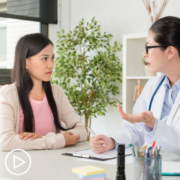Will Newer Therapies Be Curative for Diffuse Large B-Cell Lymphoma Patients?
Will Newer Therapies Be Curative for Diffuse Large B Cell Lymphoma Patients? from Patient Empowerment Network on Vimeo.
Will newer diffuse large B-cell lymphoma (DLBCL) therapies be curative for patients? Expert Dr. Nirav Shah from the Medical College of Wisconsin shares his perspective on advances in DLBCL treatments and his hopes for the future of DLBCL care.
Dr. Nirav Shah is an Associate Professor at the Medical College of Wisconsin. Learn more about Dr. Shah.
See More from [ACT]IVATED DLBCL
Download Resource Guide en español
Related Resources:
Transcript:
Lisa Hatfield:
Dr. Shah, can you give all DLBCL patients a little bit of hope, even those who are relapsed and refractory in the future sometime, can you see any of these newer therapies being curative for all diffuse large B-cell lymphoma patients?
Dr. Nirav N. Shah:
Yeah, so that’s the hope. And that’s a goal. I can tell you that in my time in practice, which is about 10 years now as a lymphoma provider, I’ve seen improvements that almost blow my mind. What’s happened in this decade, it almost seems more consequential than what happened in the 20 years prior, there have just been incredible advances, not just in chemotherapy, but immune therapy and targeted therapy, and so the goal is to keep getting better. I see a future where more and more patients with diffuse large B-cell lymphoma are cured in the front line, and more and more patients are cured in the second line.
I think it’s very, very hard, unfortunately, to say that every single patient with diffuse large B-cell lymphoma will be cured even 20 to 30 years from now, because cancer is tricky and cancer is hard, and each patient, again, is also an individual, and how they react to these treatments can also be challenging and hard. But I can tell you that my goal and the goal of so many other people like me, who not only treat lymphoma but also participating in clinical trials and do research, is to do better. And so I hope that we see a day where the great majority of patients with DLBCL are cured and able to move on and live their lives without this cancer.
Share Your Feedback:
Create your own user feedback survey


























